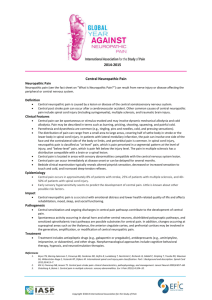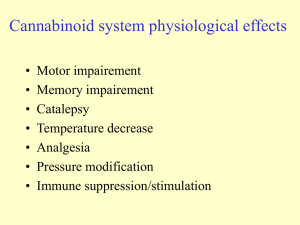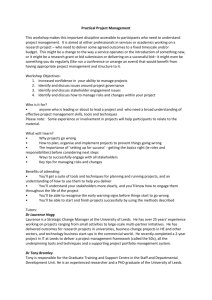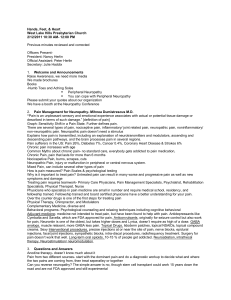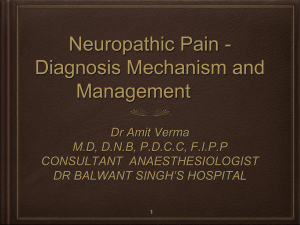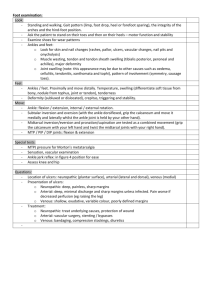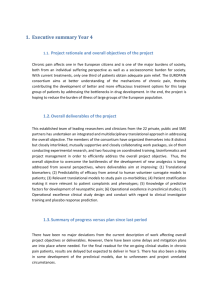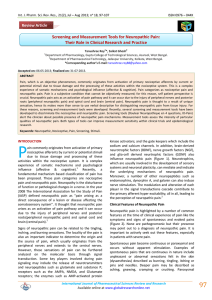ASM Speaker Prof Michelle Briggs
advertisement
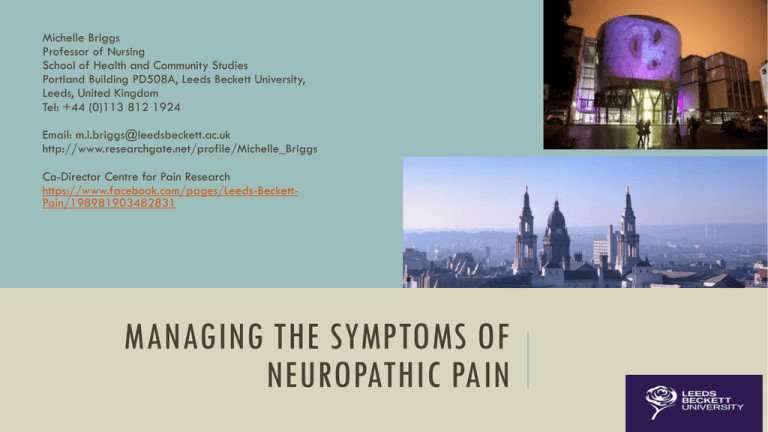
Michelle Briggs Professor of Nursing School of Health and Community Studies Portland Building PD508A, Leeds Beckett University, Leeds, United Kingdom Tel: +44 (0)113 812 1924 Email: m.i.briggs@leedsbeckett.ac.uk http://www.researchgate.net/profile/Michelle_Briggs Co-Director Centre for Pain Research https://www.facebook.com/pages/Leeds-BeckettPain/198981903482831 MANAGING THE SYMPTOMS OF NEUROPATHIC PAIN NEUROPATHIC PAIN Neuropathic pain* Pain caused by a lesion or disease of the somatosensory nervous system. Note: Neuropathic pain is a clinical description (and not a diagnosis) which requires a demonstrable lesion or a disease that satisfies established neurological diagnostic criteria. The term lesion is commonly used when diagnostic investigations (e.g. imaging, neurophysiology, biopsies, lab tests) reveal an abnormality or when there was obvious trauma. The term disease is commonly used when the underlying cause of the lesion is known (e.g. stroke, vasculitis, diabetes mellitus, genetic abnormality). Somatosensory refers to information about the body per se including visceral organs, rather than information about the external world (e.g., vision, hearing, or olfaction). The presence of symptoms or signs (e.g., touch-evoked pain) alone does not justify the use of the term neuropathic. Some disease entities, such as trigeminal neuralgia, are currently defined by their clinical presentation rather than by objective diagnostic testing. Other diagnoses such as post herpetic neuralgia are normally based upon the history. It is common when investigating neuropathic pain that diagnostic testing may yield inconclusive or even inconsistent data. In such instances, clinical judgment is required to reduce the totality of findings in a patient into one putative diagnosis or concise group of diagnoses. Central neuropathic pain* Pain caused by a lesion or disease of the central somatosensory nervous system. See neuropathic pain note. Peripheral neuropathic pain* Pain caused by a lesion or disease of the peripheral somatosensory nervous system. See neuropathic pain note. PATIENTS EXPERIENCE OF NEUROPATHIC PAIN Closs SJ Staples V, Reid I, Bennett MI, Briggs M Managing the Symptoms of Neuropathic Pain: An Exploration of Patients’ Experiences Journal of Pain and Symptom Management Vol. 34 No. 4 October 2007 NEUROPATHIC PAIN PATIENT VOICE http://lutube.leeds.ac.uk/hcssjc/videos/5288 DESPAIR & DISAPPOINTMENT ….WHY ? http://www.healthtalk.org/ Lőgren M & Norrbrink C (2012) but I know what works patient experience of spinal cord injury neuropathic pain management Disability and Rehabilitation 34;25 21392147 Objective - To systematically review and integrate the findings of qualitative research in order to increase our understanding of patients’ experiences of chronic non-malignant MSK pain. Data sources–Six electronic databases up until February 2012 (Medline, Embase, Cinahl, Psychinfo, Amed and HMIC) supplemented by hand-searching contents list of specific journals for 2001-2011 and citation tracking. Eligibility criteria for selecting studies - Full published reports of qualitative studies that explored adults’ experience of chronic nonmalignant musculoskeletal pain. Findings - We included 77 papers reporting 60 individual studies. 49 papers (37 individual studies) explored the experience of people with chronic MSK pain, and 28 papers (23 individual studies) explored the experience of people with Fibromyalgia (FM). Being Judged CONSTR UCTION OF TIME ALTERED Unpredictable now and futu re Alienated & Unrelenting body Integrated body Old me is the ‘real me’ STRUGGLE TO New me is not AFFIRM SELF Me in Pain the ‘real me’ Isolated me Connected me Why else would I have pain ? e.g. ‘age’, psychosocial factors ’, lifeevents MOVING FORWARD WITH PAIN (figure 19) CONSTRUCT AN ACCEPTABLE EXPLANATION STRUGGLING TO FIND THE ‘RIGHT’ BALANCE’ (sick/well: hide/show pain) STRATEGIES TO GAIN LEGITIMACY What is causing this and what can I do ? STRUGGLING TO NEGOTIATE THE HEALTH CARE SYSTEM NO DIAGNOSIS AMBIGOUS DIAGNOSIS FAIL TEST PAIN NON-LE GITIMATE I DON’T FEEL VALUED AS A PERSON I don’t think anyone believes me I am not just a body Believe me Be alongside me PROVING THAT I AM A GOOD PERSON INTEGRATING MY PAINFUL BODY REDEFINING NORMAL TELLING PEOPLE ABOUT MY PAIN MOVING FORWARD WITH PAIN BEING PART OF A COMMUNITY REALISING THERE IS NO CURE BECOMING THE EXPERT CHANGING DIRECTION….. THE DETECTION AND MANAGEMENT OF PAIN IN PATIENTS WITH DEMENTIA IN ACUTE HOSPITAL SETTINGS SYSTEMATIC REVIEW Nurses have been both observed and reported as not using validated tools for the assessment of pain when caring for patients with dementia in the acute hospital, Preference on simple questioning and observation of non-verbal cues (Coker et al., 2010; Manias, 2012). Coker, E., Papaioannou, A., Kaasalainen, S., Dolovich, L., Turpie, I., Taniguchi, A., 2010. Nurses’ perceived barriers to optimal pain management in older adults on acute medical units. Appl. Nurs. Res. 23, 139–146. Manias, E., 2012. Complexities of pain assessment and management in hospitalised older people: a qualitative observation and interview study. Int. J. Nurs. Stud. 49 (10), 1243–1254. REVIEW QUESTIONS 1. Which tools are available to assess pain in adults with dementia? 2. In which settings are they used and with what patient populations? 3. What are their reliability, validity and clinical utility? (e.g. do they assess pain, rather than, for example, discomfort or anxiety? do they assess pain consistently, across time, and across patients? Are they useful in clinical practice, do they add that extra information that is needed to make decisions? or is the information they provide redundant?) EXAMPLES OF OBSERVATIONAL PAIN ASSESSMENT TOOLS RESULTS: THE TOOLS 28 tools Each review compared a different set of tools, and drew conclusions on which one to recommend Some tools were reviewed only once, others appeared in multiple reviews It appeared that there seemed to be different versions of some tools FINDINGS Pain Tools No one tool appeared to be more reliable and valid than the others. Little information was available concerning clinical utility. Our recommendation: on the basis of the available evidence none of the tools could be recommended for use in clinical practice. Recommendations for Research Improve the evidence for existing tools. Develop new tools only if on different conceptual foundations? http://www.biomedcentral.com/content/pdf/1471-2318-14-138.pdf EXPLORATORY STUDY - RESEARCH DESIGN Case study approach, comparing individuals, wards and hospitals 4 Trusts - 2 wards for each Trust (extended to 5 wards in Manchester to improve recruitment) Qualitative research, observations, interviews, audit of patients’ notes Thematic analysis EXPLORATORY STUDY – METHODS Site: 3 NHS Trusts in England and 1 NHS board in Scotland Site Identifier Wards G (Glasgow) Medicine for the Elderly Continuing Care L (Leeds) Vascular (surgery) Care of the Elderly U (London) Surgical/orthopaedic Acute Medical Admissions M (Manchester) Stroke Rehabilitation Elderly Medicine (3 wards) Surgery Exploratory Study DATA COLLECTED 30 patients 30 patients observed: 8 in Leeds, 9 in Manchester; 6 in Glasgow, 7 in London 170+ hours of observations at the bedside: 71h Leeds, 22h Manchester, 45h Glasgow and 32h London 480+ hours in the field: 161h Leeds, 73h Manchester, 167h Glasgow and 85h London 52 staff and 4 carer interviews (plus informal conversations in the field) 25 in Leeds 16 in Glasgow 7 in Manchester 8 in London Period of data collection: May 2013 – September 2014 PAIN IS AN EVENT TO BE RECOUNTED NOT A THING TO BE MEASURED AND CLASSIFIED * IT IS PRIVATELY EXPERIENCED BUT OFTEN NEEDS TO BE PUBLICALLY OBS ERVED & VALIDATED TO GAIN RELIEF * WHAT DO I MEAN WHEN I SAY THAT PAIN IS AN EVENT ? BY DESIGNATING PAIN AS A ‘TYPE OF EVENT’ ….. I MEAN THAT IT IS ONE OF THOSE RECURRING OCCURRENCES THAT WE REGULARLY EXPERIENCE AND WITNESS THAT PARTICIPATES IN THE CONSTITUTION OF OUR SENSE OF SELF AND OTHER. AN EVENT IS DESIGNATED ‘PAIN’ IF IT IS IDENTIFIED AS SUCH BY THE PERSON CLAIMING THAT KIND OF CONSCIOUSNESS. BEING-IN-PAIN REQUIRES AN INDIVIDUAL TO GIVE SIGNIFICANCE TO THIS PARTICULAR ‘TYPE OF’ BEING. I AM USING THE WORD ‘SIGNIFICANCE’, NOT IN THE SENSE OF ‘IMPORTANCE’ (A PAIN CAN BE A MOMENTARY PIN-PRICK) BUT IN THE SENSE OF ‘RECOGNIZED’ (IT IS A STOMACH ACHE RATHER THAN A STOMACH GURGLE BEFORE LUNCH). PAIN IS NEVER NEUTRAL OR IMPERSONAL (EVEN PEOPLE WHO HAVE BEEN LOBOTOMIZED AND THUS LACK EMOTIONAL ANXIETY ABOUT PAIN, STILL REGISTER THAT SOMETHING THEY CALLED PAIN IS MAKING AN IMPRESSION ON THEIR BODIES). IN OTHER WORDS, A PAIN EVENT POSSESSES WHAT PHILOSOPHER PAUL RICOEUR CALLED (ALBEIT IN A DIFFERENT CONTEXT), A ‘MINE-NESS’. 9 IN THIS WAY, THE PERSON BECOMES OR MAKES HERSELF INTO A PERSON -IN-PAIN THROUGH THE PROCESS OF NAMING. JOANNA BOURKE THE STORY OF PAIN, NEUROPATHIC PAIN PATIENT VOICE :FINAL WORD http://lutube.leeds.ac.uk/hcssjc/videos/5288
